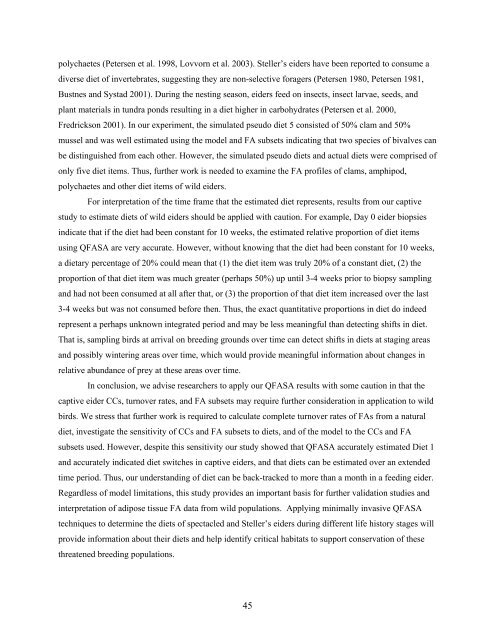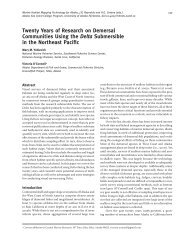724_Final Report.pdf - North Pacific Research Board
724_Final Report.pdf - North Pacific Research Board
724_Final Report.pdf - North Pacific Research Board
Create successful ePaper yourself
Turn your PDF publications into a flip-book with our unique Google optimized e-Paper software.
polychaetes (Petersen et al. 1998, Lovvorn et al. 2003). Steller’s eiders have been reported to consume a<br />
diverse diet of invertebrates, suggesting they are non-selective foragers (Petersen 1980, Petersen 1981,<br />
Bustnes and Systad 2001). During the nesting season, eiders feed on insects, insect larvae, seeds, and<br />
plant materials in tundra ponds resulting in a diet higher in carbohydrates (Petersen et al. 2000,<br />
Fredrickson 2001). In our experiment, the simulated pseudo diet 5 consisted of 50% clam and 50%<br />
mussel and was well estimated using the model and FA subsets indicating that two species of bivalves can<br />
be distinguished from each other. However, the simulated pseudo diets and actual diets were comprised of<br />
only five diet items. Thus, further work is needed to examine the FA profiles of clams, amphipod,<br />
polychaetes and other diet items of wild eiders.<br />
For interpretation of the time frame that the estimated diet represents, results from our captive<br />
study to estimate diets of wild eiders should be applied with caution. For example, Day 0 eider biopsies<br />
indicate that if the diet had been constant for 10 weeks, the estimated relative proportion of diet items<br />
using QFASA are very accurate. However, without knowing that the diet had been constant for 10 weeks,<br />
a dietary percentage of 20% could mean that (1) the diet item was truly 20% of a constant diet, (2) the<br />
proportion of that diet item was much greater (perhaps 50%) up until 3-4 weeks prior to biopsy sampling<br />
and had not been consumed at all after that, or (3) the proportion of that diet item increased over the last<br />
3-4 weeks but was not consumed before then. Thus, the exact quantitative proportions in diet do indeed<br />
represent a perhaps unknown integrated period and may be less meaningful than detecting shifts in diet.<br />
That is, sampling birds at arrival on breeding grounds over time can detect shifts in diets at staging areas<br />
and possibly wintering areas over time, which would provide meaningful information about changes in<br />
relative abundance of prey at these areas over time.<br />
In conclusion, we advise researchers to apply our QFASA results with some caution in that the<br />
captive eider CCs, turnover rates, and FA subsets may require further consideration in application to wild<br />
birds. We stress that further work is required to calculate complete turnover rates of FAs from a natural<br />
diet, investigate the sensitivity of CCs and FA subsets to diets, and of the model to the CCs and FA<br />
subsets used. However, despite this sensitivity our study showed that QFASA accurately estimated Diet 1<br />
and accurately indicated diet switches in captive eiders, and that diets can be estimated over an extended<br />
time period. Thus, our understanding of diet can be back-tracked to more than a month in a feeding eider.<br />
Regardless of model limitations, this study provides an important basis for further validation studies and<br />
interpretation of adipose tissue FA data from wild populations. Applying minimally invasive QFASA<br />
techniques to determine the diets of spectacled and Steller’s eiders during different life history stages will<br />
provide information about their diets and help identify critical habitats to support conservation of these<br />
threatened breeding populations.<br />
45



